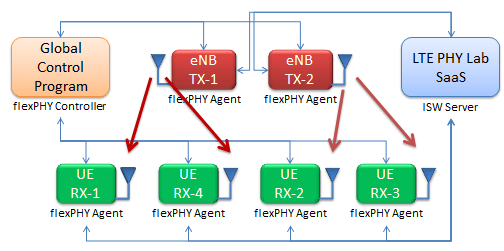WiSHFUL OC 5 Experiment wrap-up
IS-Wireless successfully completed the Experiment performed within 5th WiSHFUL Open-call. The demonstration of the results took place in June 27th 2018, during WiSHFUL final review meeting in Ghent, Belgium.
The Experiment was entitled “Flexible PHY experiments using Remote Radio and cloud processing” and it was based on IS-Wireless newly developed LTE PHY Lab SaaS (Software-as-a-Service). Our work was focused on implementation of the cloud-based solution enabling remote LTE/LTE-A modeling and hardware-in-the-loop SDR experimentation.
The presented approach assumes that all relevant components are physically distant from the user what contributes to reducing the barriers for remote research and experimentation on 4G today and 5G in the near future.

Figure 1: Experiment approach for remote LTE experimentation with the use of SDR
Background / Introduction
Aiming to bring 4G and 5G innovation for every university and research lab worldwide, we are fully engaged in development of 5G Toolset. This product group is composed of experimentation solutions, including simulation software and real-time protocol stacks. One of the key components of 5G Toolset is LTE PHY Lab – a link-level simulation tool providing a comprehensive implementation of the E-UTRA physical layer according to 3GPP Release 8, with substantial elements of Releases 9 and 10.
Recently, as a part of work within EU H2020 eWINE project, we adapted LTE PHY Lab to be available remotely on “software-as-a-service” (SaaS) basis. The purpose of this was to provide an affordable framework allowing to utilize the software even for a short period of time with no need to purchase any additional equipment and hence to reduce the barriers for 4G/5G link-level simulations. As a next step, besides the simulation capabilities of LTE PHY Lab SaaS, we planned to extend the product’s functionality by the support for SDR experimentation. The WiSHFUL open-call scope appeared to be a great opportunity to design, implement and exploit this idea, and eventually it became the basis of our Experiment.
Design of the Experiment
In the Experiment, we focused on LTE downlink transmission. In order to deliver hardware-in-the-loop testing capabilities, we provided functionality for both eNB transmitter and UE receiver. The functionalities include modeling of the physical layer processing chain at both sides as well as waveform transmission and reception using SDR platforms. The implementation of such solution is based on the following components:
- LTE PHY Lab SaaS together with dedicated interface (SaaS API)
- WiSHFUL Unified Programming Interfaces for Radio (UPIR) and Hierarchical Control (UPIHC)
- WiSHFUL facility with specific hardware (SDR) and software (GNU Radio, UHD) provided.
The whole baseband signal processing is performed by LTE PHY Lab SaaS. The communication between software and hardware units involves the usage of SaaS API, UPIR and UPIHC. Thanks to the UPIR, such approach allows performing the experiment in combination with any supported SDR platform, independently from its type, while UPIHC enables many simultaneous program executions and hence generation of a multi-cell environment.
Execution of the Experiment
The Experiment was performed at NITOS indoor testbed (University of Thessaly) with the usage of USRP nodes (models B210 and N210). We implemented and examined multiple different testbed configurations, including single-cell and multi-cell (Figure 2) environment scenarios.

Figure 2: The example multi-cell environment scenario setup
The signal generated and transmitted by each eNB was received by the group of UEs at the selected center frequency. The results collected by each UE included recovered information for MIB, CFI, HI, DCI and SIB1 as well as the computational time and SNR/RSRP measures,. In all tested scenarios IS-Wireless server limitations were not observed and hence the experimentation needs for advanced signal processing were satisfied by LTE PHY Lab SaaS.
Takeaways / Impact
- The Experiment was successfully completed and the solution for remote LTE/LTE-A PHY modeling and hardware-in-the-loop experimentation was developed and exploited.
- Multiple scenarios has been implemented, deployed and analyzed, including: single eNB transmitter, single UE receiver, hardware-in-the-loop scenarios for LTE downlink transmission in single-cell and multi-cell environments.
- The performed test scenarios allowed to validate LTE PHY Lab SaaS in the environment composed of multiple users requesting advanced and simultaneous signal processing.
- Based on the work dedicated to this Experiment, we plan to further develop our solution and implement a variety of new experimentation use-cases for academia and research community.
Call information
| Project full name: | WiSHFUL – Wireless Software and Hardware platforms for Flexible and Unified radio and network controL |
| Project grant agreement number: | 645274 |
| Project website: | http://www.wishful-project.eu/ |
| Call identifier: | WiSHFUL-OC5 |
| Experiment title: | Flexible PHY experiments using Remote Radio and cloud processing |
WiSHFUL stands for Wireless Software and Hardware platforms for Flexible and Unified radio and network control and is a frame project conducted under EU H2020 Programme with objective to lower the barrier for experimentation in view of wireless innovation creation and by increasing the realism of experimentation. WiSHFUL offers open, flexible & adaptive software and hardware platforms for radio control and network protocol development as well as advanced and portable wireless test facilities. The project started on January 1st 2015 and lasted for 36 months.